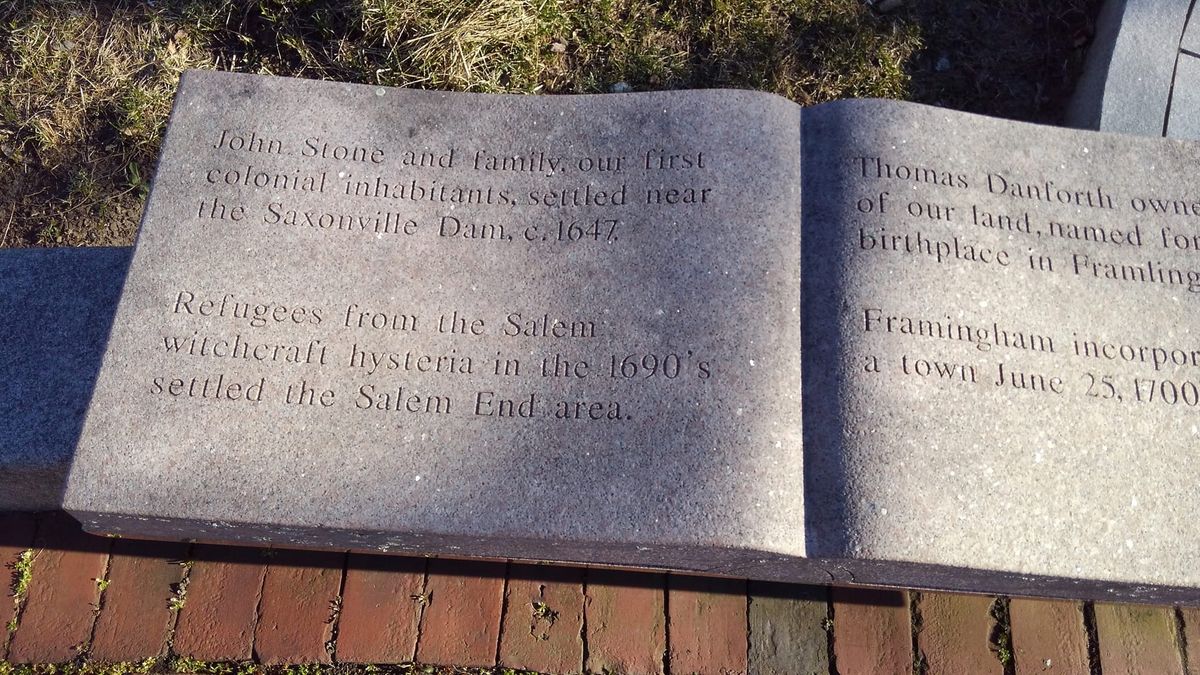About
Nestled in downtown Framingham, Massachusetts is a small park and town common which commemorates a burial ground and old footpath of the Nipmuc people. Right along the main road on Route 126 is the "Old Field of 1800" stone marker, which reads: "This the 'Old Field of 1800' was an Indian burial ground / A town common since 1854 / The gift of Lovell Eames / This stone erected under will of William Harvey Smith 1946 / The bronzes represent local Indian life. The center - carrying of corn to the hungry Bay Colonists in 1630 - The nearby trail later called "Old Connecticut Path."
People of the Nipmuc Nation lived in the central plateau of modern-day Massachusetts. Their vast territory stretched into Rhode Island and Connecticut. They fished, hunted, and grew corn. Communities would seasonally migrate between different settlements to take advantage of different areas' natural resources.
In the early 17th century, trade with Nipmuc people and other American Indians served as a crucial lifeline to early white settlers. In 1630, when starvation threatened Massachusetts Bay colonists, Nipmuc traders carried corn and other goods to the hungry colonists via an old walking path that stretched more than 100 miles from Wethersfield, Connecticut, to Boston. Today, the path is known as the Old Connecticut Path.
The names of many of these Nipmuc traders are today lost to history. However, one man of the Wabaquasset Nipmuck Nation named John Quittumog walked 60 miles from Wabaquasset (now Woodstock, Connecticut) to Boston to provide necessary resources to colonists. His contributions were later chronicled by the News-Letter of August 29, 1728, which is recorded in volume 1 of the 1874 History of Windham County, Connecticut by Ellen D Larned:
"On Monday night last, at Judge Sewall's, and the night following at Judge Dudley's, was entertained one of the oldest Indians in New England—John Quittumog, living in the Nipmuck Country, near Woodstock. He is reckoned to be about one hundred and twelve years old. The English inhabitants of Woodstock remember him as a very old man for near forty years past, and that he has all along affirmed, and which he still affirms, that he was at Boston when the English first arrived; and when there was but one cellar in the place, and that near the Common, and then brought down a bushel and a half of corn upon his back."
Without assistance from Nipmuc people and others, the English settlers would have undoubtedly perished.
But as the 17th century continued, trade relations between white settlers and various American Indian nations soon broke down. In 1671, the son of a Nipmuc leader named Matoonas was "questionably executed by the English," according to the University of Massachusetts Amherst's Native American Trails Project. Matoonas's son was accused of killing an Englishman, but there were strong doubts about his guilt and many believed he was innocent.
Matoonas soon rallied against the English siding with the Wampanoag chief Metacomet (also known by his adopted name Phillip) in King Phillip's War, which was named after Metacomet. The rest of the Nipmuc Nation joined Matoonas against the English.
The war ended with Metacomet's death on August 12, 1676 leaving many Wampanoag and Nipmuc people executed, enslaved, or displaced and left to perish on Deer Island.
Even after the war, some Nipmuc people continued to defend their settlement in Quinsigamond (modern-day Worcester, Massachusetts), and today Nipmuc people continue to live in Worcester and the surrounding area.
Related Tags
Know Before You Go
There are parking spots along Park Street and the best time to visit would probably be on the weekends or other days where there is less traffic. There are also other stone markers detailing some of the local history of Framingham.
Community Contributors
Added By
Published
May 17, 2023




























